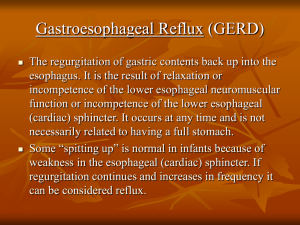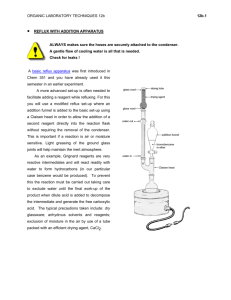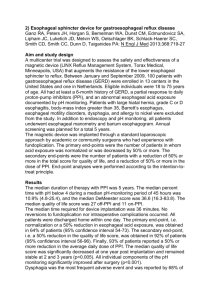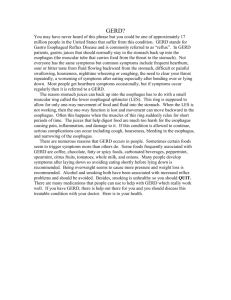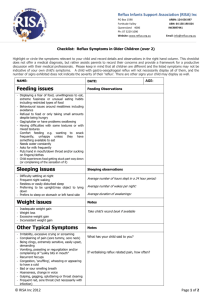The Co-existence and Severity of Acid and Alkaline Reflux in
advertisement
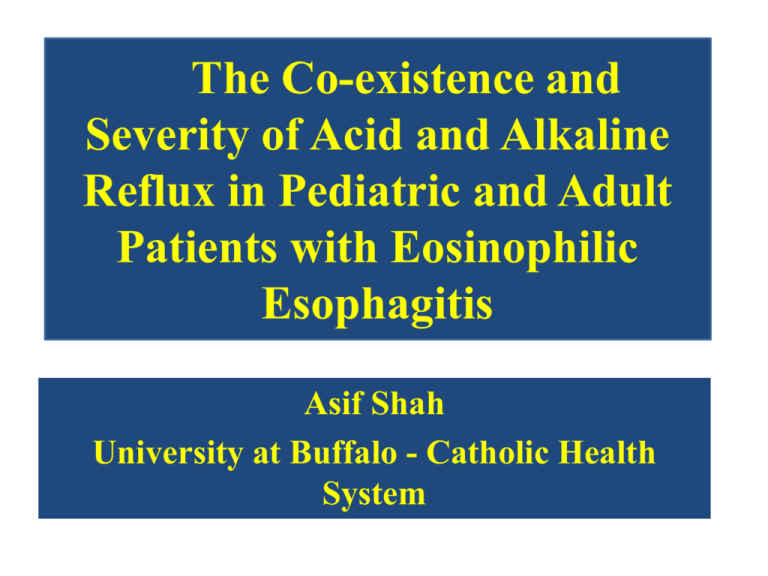
The Co-existence and Severity of Acid and Alkaline Reflux in Pediatric and Adult Patients with Eosinophilic Esophagitis Asif Shah University at Buffalo - Catholic Health System INTRODUCTION Eosinophilc Esophagitis • Allergic inflammatory condition of the esophagus. • Similar in presentation to GERD. • Symptoms include heart burn, swallowing difficulty, food impaction etc. • Diagnosis: • Upper GI Endoscopy with Biopsy • • • • Histology: 15-20 Eosinophils/hpf Rx: Swallowed corticosteroids- Fluticasone and Budenoside GERD • Inflammation of esophagus secondary to reflux of acidic gastric contents into the esophagus. • Clinical presentation similar to EE. • Diagnosis: • 24-hr esophageal pH monitoring. • Histology: • 4-5 Eosinophils per hpf • Rx: • PPI’s • H2 Blockers Distinguishing features Eosinophilic Esophagitis • Heart burn, food impaction • Upper GI endoscopy • 15-20 Eosinophils/hpf • Corticosteroids • ?? PPI GERD • Heart burn,food impaction • Upper GI endoscopy • 4-5 Eosinophils/hpf • 24 hr esophageal monitoring • NO CORTICOSTEROIDS • PPI’s • H2 Anatgonists CAN EE AND GERD COEXIST IN THE SAME PATIENT ? BACKGROUND Background • There is a continuous controversy regarding the coexistence and clinical significance of EE and GERD in the same patient. • Most studies from tertiary centers. • Increased expression of eotaxin-3 distinguishes between EE and GERD Bhattacharya, Carlsten et al Background contd….. • The recent translational study by Blanchard et al and Bhattacharya et al brings molecular clarity to clinical suspicions that GERD and EE are distinct. Review article: the pathogenesis and management of eosinophilic esophagitis G. T. FURUTA* & A. STRAUMANN Eosinophilic esophagitis in children and adults: a systematic review and consensus recommendations for diagnosis and treatment. FURUTA GT ET.AL; GASTROENTEROLOGY 2007 OCT;133(4):1342-63 Background ..Contd… • “PPI therapy should not be considered as a primary treatment for patients with EE. It may be considered as co-therapy because it sometimes alleviates symptoms in part (Grade C).” • “It is interesting to speculate that the esophagus of EE patients may have enhanced sensitivity to acid, even in the absence of pathologic reflux.” Aim of the study • To determine the frequency of pathologic acid and alkaline reflux in patients seen in a private practice setting with biopsy proven EE • Compare reflux severity to control patients with only GERD Study Design • Retrospective chart review • Out-patient GI clinic Study Design contd…. • Comparison of the frequency and severity of pathologic reflux in patients with EE • Vs • Patients with pathologic reflux only based on 24 hr esophageal pH monitoring Case Selection • • • • • • Identified using ICD-9 Diagnostic code for EE Time frame : Jan 2006-July 2009 41 cases identified EGD and Biopsy proven EE Fulfilling the following criteria: i) ≥ 20 Eosinophils per hpf on histology Case Selection contd… • Advised to undergo routine evaluation for EE • Including allergy testing • 24 hr Esophageal pH monitoring was performed. Case Selection contd.. • 27 patients were included in the study • 4 patients did not complete the 24 hr pH probe • 10 patients diagnosed with other GI disease (eosinophilc colitis) Control Selection • Sex and age matched control group was obtained • 21 controls identified • Selected from pH impedance database 41 patients identified using diagnostic code for EE 14 patients did not complete probe / Dx with other disease 27 patients included in the study 13 cases had acid index >4 14 cases had acid index < 4 Control Selection contd… • Inclusion criteria: • EGD documenting absence of eosinophilia • Diagnosis of pathological GERD was based on: • i) Reflux index > 4% • ii) DeMeester Score 14.72 Statistical Methods • Univariate statistical analysis was used to compare variables within different groups • Statistical Analysis was performed using SAS Statistical analysis software version 9.2 (SAS Institute Inc, Cary, NC, USA). • • A nominal significance level of 0.05 was used. Results • 41 cases were identified • 14 were excluded from the study secondary to refusal to complete pH probe or diagnosis of other disease • 27 cases included in the study Case Characteristics: age & sex • • • • Mean Age of cases 14.81 yrs All the cases were more than 1 year of age 17 were males 10 were females Control Characteristics: age & sex • • • • Mean age of controls was 9.14 years. 10 were males 11 were females None was less then 1 yr of age. • There was no statistical significance between the cases and contols in these variables Characteristics Case (n = 27) Mean (std) 14.81(14.48) Control (n = 21) p-value 9.14(4.69) 0.0716 Age Median(Ran 12.00 9.00 ge) (3.00-67.00) (1.00-19.00) Male 17(62.96) 0.1223 10(47.62) Sex 0.1642 Female 10(37.03) 11(52.38) Reflux Index and DeMeester Scores • Mean Acid Index (cases) 5.55 • Mean Acid Index (controls) 6.32 • Statistically significant with p-value 0.008 • Median Acid Index (cases) 3.80 • Median Acid Index (controls) 5.60 • Statistically significant p-value 0.0042 Characteristics Acid Index Case (n = 27) Control (n = 21) p-value Mean (std) 5.55(6.61) 6.32(2.00) 0.0088 3.80 (0.8033.00) 0.0042 Median(Ra nge) >4 5.60 (4.2012.20) 13(48.15) 21(100.00) Acid Index <0.0001 <=4 14(51.85) 0(0.00) Reflux Index and DeMeester Scores • • • • 13 cases had acid index >4 14 cases had acid index <4 All the controls had acid Index >4 Statistically significant p-value <0.0001 Reflux Index and DeMeester Scores • Mean DeMeester score (cases) 19.27 • Mean DeMeester score (controls) 22.15 • Statistically significant with p-value 0.0095 • Median DeMeester score (cases) 13.24 • Median DeMeester score (controls) 19.38 • Statistically significant with p-value 0.0063 Case (n = 27) Control (n = 21) p-value Mean (std) 19.27(21.50) 22.15(7.39) 0.0095 Median(Range) 13.24 (3.30-104.72) 19.38 (15.04-45.55) 0.0063 >14.72 12(44.44) 21(100.00) Characteristics Demeester Score Demeester Score <0.0001 <=14.72 15(55.56) 0(0.00) Other Characteristics • Number of Reflux episodes • Alkaline Reflux • Bolus Transit Time Case (n = 27) Control (n = 21) p-value Mean (std) 56.43(63.06) 50.87(25.55) 0.7878 Median(Range) 44.20 (13.10-342.80) 50.70 (14.10-106.40) 0.5137 >50 9(34.62) 11(52.38) Characteristics Num of episode Num of episode 0.2503 <=50 17(65.38) 10(47.62) Mean (std) 15.20(17.82) 9.48(11.91) 0.1719 Median(Range) 6.75 (0.10-59.00) 3.10 (0.00-37.90) 0.1813 Mean (std) 26.69(41.18) 34.19(64.72) 0.4871 Median(Range) 16.20 (3.90-210.00) 19.80 (2.70-313.00) 0.3109 Alkaline reflux Bolus transit time Correlation • No correlation between the number of eosinophils per hpf and - Refulx Index - DeMeester score Conclusions • In EE patients the mean and median acid index (mean = 5.55 vs. 6.32) and DeMeester score (mean = 19.27 vs 22.15) were statistically significantly less than in the patients with GERD. • Alkaline reflux, bolus transit, and number of reflux episodes were similar. 48%-44% • However, approximately half of EE patients met the criteria for pathological reflux based on Reflux Index (48%) and DeMeester score (44%). Conclusions… • EE and GERD frequently co-exist, but the reflux is less severe than in patients treated solely for GERD in the private practice setting. • Both EE, GERD should be tested for and treated simultaneously for maximal benefit to the patient Strengths • Bigger sample size in comparison to other similar studies • New direction to EE Limitations • Retrospective chart review. • Need to increase sample size. • Out-patient center. Acknowlegements • • • • • • Dr. Maya Srivastava Dr. K. J. Qazi Dr. Michael Moore Dr. Mayur Virarkar Ms.Rameela Chandrashekhar Catholic Health System
